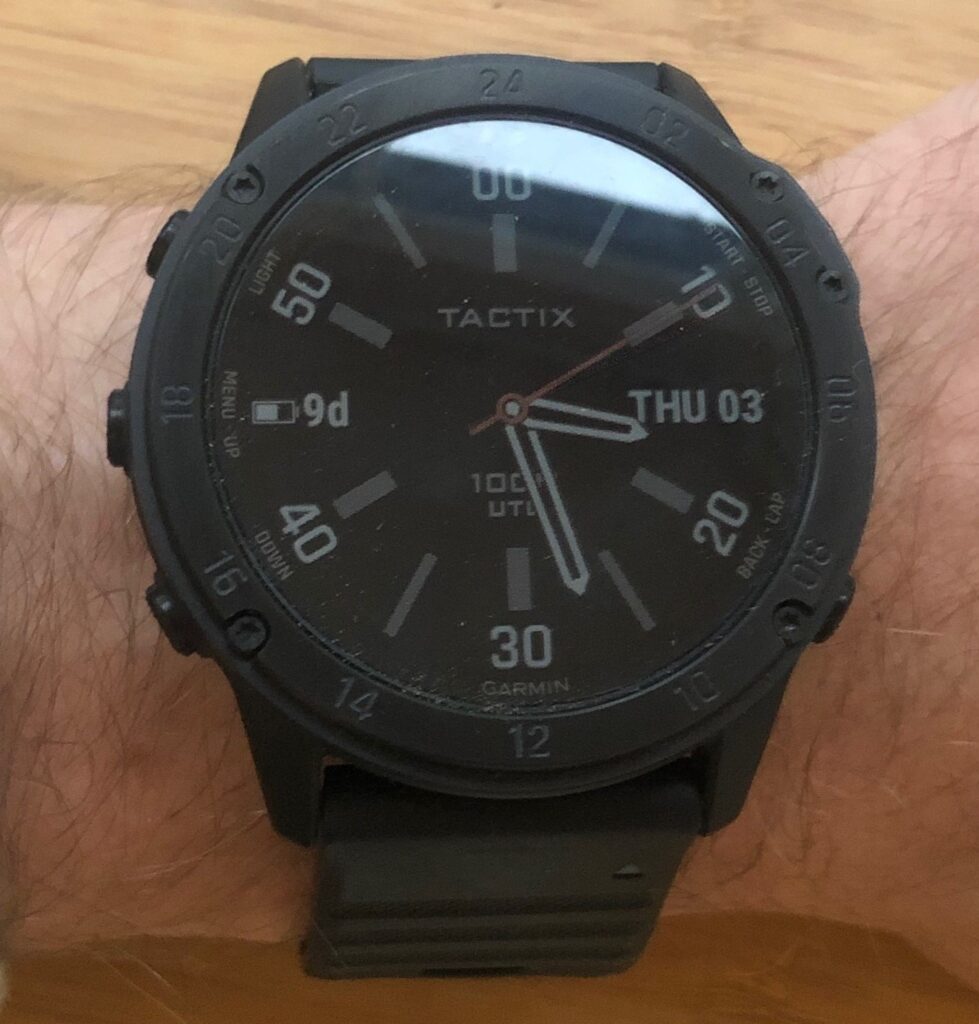All your Garmin Tactix Delta questions answered
Because it’s such a fully-featured watch and has so many settings and options, it was hard when writing my Garmin Tactix Delta review to cover all the questions people might have.
To try to remedy that, and after a couple of months of wearing it myself and figuring out the answers to a lot of my own questions, here is a little roundup of some of the questions people may be asking.
One point to note: the Tactix Delta is a step up from the Fenix 6 in both price and functionality. We’ve written a head-to-head post here so that you can compare the two devices and better choose the option that suits your needs: Garmin Fenix 6 vs Tactix Delta.
Looking for options that better fit your budget?
What is Garmin pulse ox?
One of the metrics that will be new to a lot of users of the Garmin Tactix or Fenix Pro is ‘pulse ox’. So what is this, how does Garmin calculate pulse ox, and what does it mean?
Well, a pulse oximeter uses infrared light bounced off the blood circulating inear the skin surface to detect how much oxygen the blood contains. These can be used anywhere that capillaries are reasonably close to the surface, and are commonly done on the fingertip. The device you’ll often see on the fingertip of almost any patient in the hospital, or even being treated by paramedics, is almost certainly a pulse oximeter.
Garmin uses the same method but on the back of the wrist – where it is already using infrared to detect your heart rate. The figure this provides is your blood oxygen saturation, or SpO2, which is a percentage (i.e. a figure from 1-100).
Although generally speaking only people with medical conditions need to worry too much about their blood oxygenation, it is useful for anyone (and especially for athletes) to know what is normal for them and to be able to identify any shift away from normal, as that may indicate health problems or difficulty breathing while exercising. Measuring your SpO2 while you’re asleep (which is one of the possible settings on the Tactix) can also be valuable as a way to identify breathing difficulties when you’re sleeping that could potentially be fixed by something as simple as a different pillow or (in my case) using nasal strips.
In addition, looking at your SpO2 can be very useful if you are training at altitude, as it’s to be expected that when you first move to a higher altitude your blood oxygenation will decrease, but should eventually return to something close to normal as you acclimatise. This can give you an excellent indicator of when you are fully acclimatised to that altitude.
What is a good pulse ox?
Garmin marks any SpO2 above 90 in green, while 80-89% is yellow, 70-79% is orange and bellow that is an even darker orange. That gives a rough indication that anything below 90% may be problematic, although in the small print, even Garmin says ‘Ideally your SpO2 should be 95-100%’, so figures between 90-95% are, let’s say, not something to seriously worry about but also not ‘ideal’.
Those figures broadly align with medical advice elsewhere, for example, Healthline says that “Normally, a … pulse ox (SpO2) below 95 per cent is considered low.” Crucially, however, it goes on to say that it’s important to know what is normal for you, especially if you know you have some sort of chronic condition. As with many of these figures, observing variation from your normal is often more valuable than worrying too much about what is a ‘good score’ in isolation.
How to improve the Garmin Tactix Delta battery life?
One issue that plagued me in the first week of having the Garmin Tactix was battery life. I knew it was supposed to have a superb battery life – at least two weeks under normal conditions – and what’s more I’d used the very similar Garmin Fenix enough to know that the long battery life was real, and not just marketing spin. Yet my freshly-charged Tactix was showing just 7 days battery remaining, and that seemed to be falling even faster than I’d have expected, as less than 24 hours later it was down to 5, having only used it for a quick 40-minute run. What on earth was going on?
Well, the trouble is that there are a lot of variables that can affect the battery life. All of the below will play into it in some respect, but I think there was one major setting that made the biggest difference in stopping the battery drain on the Garmin Tactix, and I’ll come onto that.
- How much you use it for GPS-based activities
- How often it syncs with your phone
- Whether you use it for music
- How often do notifications come from your phone and show on the watch
- How often do you use the backlight
And so on.
But the main culprit? WiFi. The Garmin Tactix Delta comes with WiFi inbuilt which, if it’s connected to a network, allows it to upload activities without syncing to your phone, and is essential for downloading tracks on Spotify. However, the problem seems to be that if you leave the WiFi on the default setting of ‘on’ and ‘auto-upload’, this can have a huge impact on battery life as the watch is constantly hunting for networks and attempting to connect to ones it finds while you’re out and about.
You can somewhat improve this by going into ‘settings’ then ‘WiFi’ and turning off ‘auto-upload’. You’re unlikely to miss it as it duplicates functionality you would get by simply syncing with your phone. For me, that didn’t do enough to improve the situation though, so I turned the WiFi off altogether and, sure enough, the next time I charged the phone it showed 15 days and, indeed, easily lasted two weeks without needing another charge.
The impact of having the WiFi off is pretty minimal for me, as I tend to play Spotify off my phone so I’m not regularly downloading tracks. If I was using Spotify more, I’d have to just get into the habit of turning the WiFi on, downloading what I needed, and then turning it off again.
If anyone finds a way to keep the WiFi on but avoid the battery drain, do let me know in the comments!
How can you check the battery level on the Garmin Tactix?
This might seem like a simple question, but the smart battery management settings on the Garmin Tactix (and the Garmin Fenix) mean there’s a bit more to this answer than you might think!
First off, the easiest way to be able to check your battery level on the Tactix or Fenix is to place it as one of the data points on your watch display. Most of the watch faces available to you have at least a couple of customisable data fields where you can put information such as day, date, heart rate, altitude, or battery level. I’d say that, for most people, day/date and battery are two of the most useful fields to show, and that’s what I have on my display so I can easily see how much battery I have left at a glance. This is shown with a little battery icon and (even more useful) the number of days remaining in the current usage mode (i.e. standard smart-watch mode).

If you can’t spare one of the fields on your watch display, because you want to use them for other data or you have a very minimalist display with no extraneous fields, that’s ok – there’s still an easy way to check your battery level. Just press the ‘down’ key to go into your list of widgets, and at the top, it will show the day and date, and the remaining battery.
Finally, though, because Garmin cleverly calculates how much battery life is remaining based on the activity or mode you are in, you can also check this for individual activities and even for power settings within an activity. Simply go to any activity and, before you press the start button, the options widget will appear at the top of the screen, and will alternate with a display showing the amount of time the battery would last in that specific activity. This is extremely useful if, for example, you are about to set off on a long run and want to make sure the watch won’t die part-way through.
What does Garmin’s body battery mean?
Another metric that was new to me on the Fenix, and then on the Tactix, is the ‘body battery’. So what is this, and what does body battery mean?
Essentially, body battery is just a convenient way to visualise two other metrics:
- Heart-rate variability (as used for the Garmin stress score). A low-stress score increases your body battery, while a high one reduces it.
- Activity, which reduces your body battery.
The end result is a rough gauge of your overall energy level. So how can you use the body battery score? Well, it gives you an idea of how ready you are for exercise, or when you’re a bit too drained and need to take it easy. It can also help to quantify factors that can otherwise be hard to identify such as if you’re not sleeping well and therefore waking up still partially drained, if several long days at work have left you drained, or if a particularly restful holiday has given you several days where your body battery hardly reduces at all. All of these can be useful information to better manage your lifestyle and training programme.
How does this compare to the Garmin Tactix Charlie?
We anticipated the ‘Garmin Tactix Charlie vs Delta’ question! The Charlie is the slightly older edition of Garmin’s premium tactical and hiking watch, released in 2018, but is largely very similar with only a few small incremental improvements added to the Delta.
The main differences between the Garmin Tactix Charlie and Delta are:
- The Delta is a little thinner, at 14.9mm to the Charlie’s 17.5mm.
- The Delta has a display that is both slightly larger and slightly higher resolution.
- The Garmin Tactix Delta has substantially improved battery life over the Garmin Tactix Charlie, particularly with the addition of the expedition mode.
- The Delta has a lot more of Garmin’s latest health monitoring functions that were not present on the Tactix Charlie, in particular stress monitoring and pulse ox, amongst others.
- The Delta adds Garmin Pay, as well as the ability to store music and play it back from the watch, while the Charlie can only control music playing on your smartphone.
- The safety and incident detection features are only available on the Delta. The Garmin Tactix Charlie does, however, have live tracking.
- The Garmin Tactix Delta adds two new tactical features not present on the Charlie: the kill-switch and stealth mode.
- The Delta has some additional pre-loaded workouts for strength, yoga and pilates including on-screen animations to guide you through them. These are not available on the Garmin Tactix Charlie, although the activity types are present to track your workouts.
- Trendline routing is new for the Garmin Tactix Delta.
- Most of the detailed training metrics are new on the Delta – including training effect, heat acclimatisation, and Physio TrueUp.
If these sorts of features aren’t particularly important to you then the Garmin Tactix Charlie could be a great way to get most of the functionality of this brilliant watch series, at a significantly lower price.




